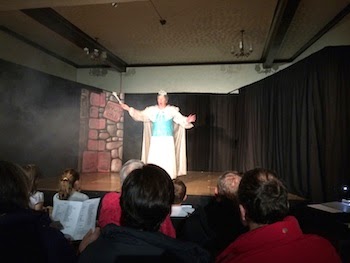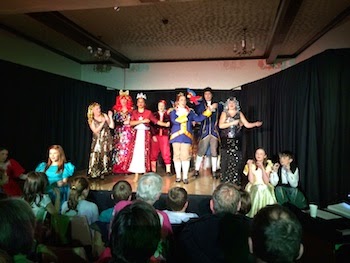A few days after our arrival in Kirkby Stephen, a picture-perfect little village in the English Cumbrian countryside, we were presented with an opportunity to attend a traditional English pantomime. “What is it?” we asked, sensing it wasn’t what we Americans associate with that word, and on learning that it’s–basically–community theatre with a few English traditions rolled in, we replied, “Count us in.” We had, after all, already enjoyed a couple of big commercial productions in England this year (“Around the World in 80 Days” and “Wicked”), so a small, local production sounded quaint and fun.
Now, having experienced something like this, we usually do a little bit of research on the traditions so we can learn a little background and share it with you in our blogs. Wikipedia is one of our go-to resources, and this is what Wikipedia has to say about Pantomime:
Whoever contributed this description of English pantomime to Wikipedia absolutely nailed it, at least from what we can tell from our single experience with it. We can’t think of a single way to add to this description or to improve upon it. So we’ll just say that “Cinderella”, performed by Kirkby Stephen’s More Than A Handful troupe as their 2014 pantomime, was an absolutely perfect example of traditional pantomime.
 |
| Cinderella’s Fairy Godmother and Pantomime MC |
Everyone knows the story of Cinderella, which I think is why pantomime performances are based on well-known tales: you don’t have to concentrate on the plot and can enjoy the uniqueness and local spin they put into it. It was indeed a family affair, put on in the events room of a local pub near the town’s center, with local children making up most of the front row. Their pantomime Cinderalla included the requisite music, comedy, and dance with local references that might have gone a bit over our heads, but we got the gist. There was indeed a cross-dressing actor: Cinderella’s nasty stepmother was played by a bloke we met a few days earlier. And with great fun, it’s wonderfully participatory: the audience is enlisted to remind a character to pull up their socks every time they appear on stage, and at the end everyone is asked to join in and sing along to “Show me the way to go home.”
While everyone in the cast did a great job, and everyone–cast and audience–obviously thoroughly enjoyed doing Kirkby Stephen’s 2014 pantomime, there were a few of the actors that we especially wanted to applaud. Mick Botterill played (we believe) a deliciously nasty, and rather unattractive, wicked stepmother. Baron Hardup, Cinderella’s father, was played wonderfully by Richard Staley. And our favorite performer was Daisy Bradburn-Sims playing Buttons, Cinderella’s buddy and our (the audience’s) guide through the story.
 |
| “Cinderella”, Kirkby Stephen’s 2014 Pantomime |
We can’t adequately tell you in a blog how much fun this was, and it’s another great example that one of the best sights you can enjoy while traveling is the local performing arts. We’ve gone to string quartets, chamber performances, and piano concerts in Venice and Rome, those big theatre productions in Manchester and London, and small performances like this–we’re going to see a performance of Handel’s Messiah at Kirkby Stephen’s parish church this coming week–and we’ve loved them all.
 |
| “Cinderella”, Kirkby Stephen’s 2014 Pantomime |






